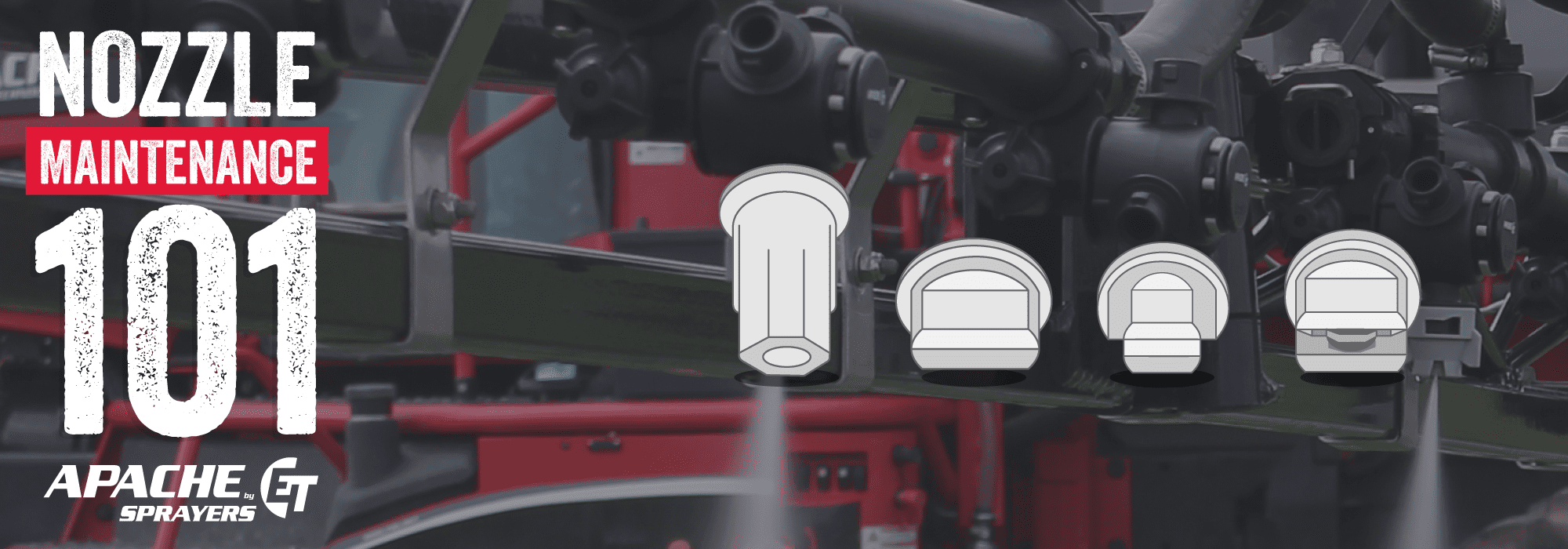
Whether you are top dressing wheat or doing pre-plant herbicide applications, there are a few things to remember when servicing sprayer nozzles and tips. To help our customers solve some of the most prevalent problems in the field, the Apache Sprayer team got together with additional experts within the industry to gather the best tips for nozzle care throughout the year.
QUICK TIPS FOR SPRAYER NOZZLE MAINTENANCE
Start the season by running clean water through the sprayer and at the end of each spraying day, to thoroughly clean the spray tips. Chemicals will eventually gum up the tip and cause uneven spray patterns or, worse, plug the tip completely.
Always use water or compressed air to clean a spray tip. Using sharp objects such as a pocket knife or a piece of wire will cause damage to the tip. With proper care, you can extend the life of spray tips significantly.
“Most problems with spray tips are a result of a lack of maintenance and calibration,” said TeeJet Technologies Manufacturer Representative, Bryan Fowler. “Taking a close look at the spray pattern for consistency and distribution across the boom will alert you to the problem sooner and help you avoid poor application results. Many times, it can be difficult to look at a tip and actually see a problem.”
The Importance of Nozzle Cleaning
“Nozzles need to be protected from plugging through the use of strainers upstream of the nozzle,” Smart said. “But even with proper straining, nozzles can sometimes plug. Nozzles that come apart easily (without the need for tools) and that have visible metering orifices will speed up the cleaning process. Air, water and the occasional broom straw or toothbrush is all that should be used for cleaning.”
Boom Height and Sprayer Nozzle Correlations
Smart says boom height is also important to create a uniform distribution of the spray with your selected nozzle.
“A good rule of thumb for 110-degree nozzles is matching the nozzle spacing to the boom height,” Smart said. “So, for 20-inch spacing, a minimum 20-inch boom height will ensure uniformity along the length of the boom. Keeping the boom as close as possible to this target will also maximize coverage, penetration and drift control.”
Sprayer Nozzle Tests and Checks
Fowler suggests performing a catch test on a few of the tips to better analyze the issue. A catch test uses a catch cup over the nozzle to measure output and flow rates.
“It is a good practice to perform a catch test on a few of the tips; if a few are out of specification by more than 10 percent, then it is time to replace them,” Fowler said.
“This means that a tip that is rated to spray 0.4 GPM (ex. XR8004) at 40 psi is actually spraying 0.45 GPM, it should be replaced. If more than a few tips on the boom are performing this way, all of the tips on the boom are probably worn and will need to be replaced.”
It’s very hard to detect nozzle wear by sight alone as there can be very little evidence of wear. Greenleaf Technologies Regional Sales Manager William Smart agrees that nozzle checks are an essential part of upkeep, but also stresses the use of strains and boom height adjustments to prevent malfunctions.
Apache Spray Nozzle Pressure Issues and Chemical Buildup
A pressure drop in your Apache sprayer can really put a kink in proper spray coverage. When this happens, it’s likely due to a chemical sediment build up clogging the strainers in the nozzle tips. Apache sprayers are equipped with the solution.
To help keep nozzle tips from becoming blocked, each boom section includes a 1-inch strainer with a 50-mesh screen and a 2-inch full-port Banjo® main product strainer with a 50-mesh screen.
“If the 2-inch strainers become clogged the boom pressure could drop, if the 1-inch section strainers become clogged the boom pressure could increase,” said Gary Grant, Ohio Valley Ag Equipment Specialist. “Both could result in poor spray pattern and inaccurate application rate problems. Anytime you recognize a pressure change in your normal operating range, strainer clogs or other blockage factors need to be addressed immediately.”
If chemical build up still occurs, it’s time to remove the strainers and clean them. This is done by soaking the strainers in a large bucket filled with water and a small amount of dishwashing liquid for around 20 minutes. Most of the sediment will dissolve.
What doesn’t dissolve can be scrubbed away with a cleaning brush. To prevent this problem from happening in the future, run the rinse tank on the sprayer to clean out the booms if you think the sprayer will be sitting idle for two (or more) days. If your sprayer is parked for a longer period of time, run the agitation in the tank to keep the tank mix stirred.
Quick Tips for Nozzle Care
- Run the rinse tank to clean booms if there has been significant downtime between sprays.
- Run the tank agitation function if the sprayer has been idle for several days.
- Remove and clean strainers with dishwashing liquid and water if clogs persist.
Need Help With Any Sprayer Issues?
For questions and concerns about your Apache sprayer pressure, please contact your closest Apache dealer for assistance.
For more information, check out our handy white paper.


